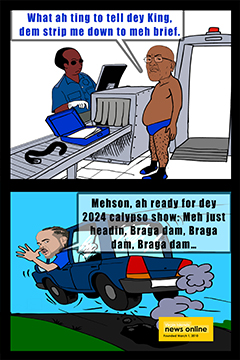UPDATE: USVI Judge rules in Black landowner’s favour

![The story concerning Mr Bernard Cuffy has captured the attention of the entire US Virgin Islands community as well as the [British] Virgin Islands. Photo: VINO](https://www.virginislandsnewsonline.com/cache/images/350x_m_Mr_Cuffy.jpg)
FREDERIKSTED, St Croix, USVI— An important and landmark victory was handed down in the Superior Court on June 2, 2019 on St Croix, US Virgin Islands (USVI) by Judge Jomo Meade to Bernard Cuffy, which will cement moving forward how land disputes relative to right of way (ROW) are handled in the [US] Virgin Islands for subdivision property owners.
Judge Meade denied all relief sought by the plaintiffs — Brian and Cynthia Devlin, Patricia H. Babij, Austin McKenzie, Sr, Andrew and Karen Hooker, Charles Adams, and Lynn Cameron Pontius — against Mr Cuffy, including emergency relief and an emergency order that sought to stop Mr Cuffy from clearing the ROW path to his #38 Clairmont property.
The story concerning Mr Cuffy has captured the attention of the entire Virgin Islands community and even those from other jurisdictions watching on The Consortium’s Facebook platform. The video interview has been viewed over 124,000 times. Mr Cuffy told The Consortium in the interview that neighbours to his Clairmont plot were attempting to block him from using the pathway not because of security, as he said they claimed, but because he is not White. “It’s going to be a security issue for them because I am not White. That’s the problem,” said Mr Cuffy, who owns Carpet Masters, a firm offering rug and carpet cleaning as well as sales. “They want to control the mountain. You can’t control the mountain, it’s not yours. It’s a subdivision. This is the Virgin Islands.”
Attorney Mark Eckard, who represented the plaintiffs, tirelessly argued that the right of way was on private property, and therefore Mr Cuffy should not be allowed to clear a path. His position was refuted time and time again by employees of the Department of Planning and Natural Resources, an expert surveyor and Judge Meade himself.
Star witness testifies
In court on Tuesday, defense Attorney Gertrude LeCointe introduced a star witness to the stand, Wayne D. Callwood, the Virgin Islands territorial public surveyor for the last ten years. Mr Callwood’s work includes approving maps and deeds, among other roles. He had reviewed maps 5472, 2161 and 1407, to determine the right of way for the subdivision on which Mr Cuffy’s land sits, and established, like the expert testifiers before him, that the right of way indeed remains in place as part of the subdivision.
The pathway for the road leading to Mr Cuffy’s property is 30 feet wide. From the center moving outward 15 feet on either side along the road belongs collectively to the property owners equally, Mr. Callwood made known, and this makes up the ROW. Even so, he added that all land in the territory is subject to Virgin Islands law, and contrary to Attorney Eckard’s argument that Mr Cuffy needed permission from the neighbours to clear the path to his home, the only permission Mr Cuffy needed, Mr. Callwood said, was from the Government of the Virgin Islands through DPNR, which he has already secured.
Mr Callwood also cited Virgin Islands Code Title 29, Subsection 230, which reads, “The use of any roadway or street onto, within or through any subdivision of residential development of ten or more dwellings, which roadway or street is open to the use of any other persons as guests, visitors or permittees, other than the actual inhabitants thereof, shall not be denied or restricted directly, indirectly or by subterfuge, to any person, subject only to the conditions and limitations established by law and applicable in like manner to all persons.“
Furthermore, Mr Callwood stated, Virgin Islands deeds say owners are subject to easement, right of way and Virgin Islands law.
Another witness called to the stand, Norman Smith, who Mr Cuffy has hired to clear the pathway to his lot, spoke on how he intends to do the job without damaging any of the encroachments found on the roadway before they are eventually replaced.
More roadblocks for plaintiffs’ attorney
Attorney Eckard did not deviate from the line of argument that he had maintained throughout the two-day trial. On Tuesday he said because the pathway runs on the properties of multiple owners, permission was needed before anything could be done. This time, however, he was shutdown by Attorney LeCointe. She mentioned the current encroachments on the right of way, including the steps, a pedestal on which electric boxes are installed, a septic tank, and a fence, among others — all encroachments by current property owners. Who did they consult? The room fell silent.
Attorney LeCointe said Mr Devlin, during the temporary restraining order hearing had called the pathway his backyard. “They have encroached and they are trying to protect their encroachments,” Attorney LeCointe contended in closing arguments. She said if the plaintiffs were granted their wish, “it would have open a can of worms.” In another instance, she said if Mr Cuffy was not given his right of way, “it would be pandemonium here,” not referring to violence, but the avalanche of cases that would arise.
Arguments insufficient
Judge Meade, following closing arguments, immediately ruled on the matter, deeming the plaintiffs’ argument insufficient to meet the burden of their suit’s demands. Throughout the trial, the judge would seek to have Mr Eckard explain why a man who purchased a plot of land that is part of a subdivision, with a right of way to get to his property, should not be allowed to do so.
As Mr Eckard argued of future occurrences that may come as a result of Mr Cuffy clearing the path to his plot, which Mr Eckard described as steep, Judge Meade said, “If Mr Cuffy wants to expend money to pay to build on a steep hill, you cannot stop him.” The hill Attorney Eckard has contended to be steep, was not seen as such by the defendants.
Victory for the Virgin Islands
Following the judgement, a number of individuals expressed elation, including Mr Cuffy’s wife, Athlene. “We are ecstatic that justice was served not just for us, but for the entire Virgin Islands community. We [were] able to preserve our heritage for all Virgin Islanders.
Mrs Cuffy added, “We encourage Virgin Islanders not to be bullied and stand up for your rights. Fight back.”
Senator Javan E. James, who attended the trial on both days, said, “This shows the importance of the first branch of government and the laws put in place to protect the people of the Virgin Islands. No one is above the law.” He said part of the reason he attended the trial was to glean information that would help him forge legislation to ascertain that Mr Cuffy had his right of way, if the defense had lost.
Mr Cuffy, at the center of what became one of the most important trials and verdicts in the territory as it sets an important and definitive precedent, said the victory was not just for him but all Virgin Islanders.
“This is not for myself but the entire Virgin Islands,” he said. Mr Cuffy said even if someone is timid, this person should not back down from standing for their rights. “People should not back down and cower,” he said.
Mr Cuffy expressed a willingness to help anyone going through a similar situation. “I am willing to help for the rest of my life anyone who gets in a similar situation.”
Mr Cuffy also expressed an extreme sense of Virgin Islands pride, talking of the overwhelming support he received following the publication of the story and video on VI Consortium platforms.
“I appreciate all the support I have received, and I say thank you, thank you, thank you,” he expressed.
Attorney LeCointe brought overwhelming evidence to the trial, revealing witness after witness — like the DPNR employees and the territorial public surveyor, Mr Callwood, to the stand. She told The Consortium following the judgement that she was pleased with the outcome.
“I’m just happy that justice was served. They were attempting to do something unfair. I think they were assuming he’d go away like McKenzie. They underestimated him and the people of the Virgin Islands who rallied together,” Attorney LeCointe said. She said Attorney Eckard’s argument did not make sense. “Any reasonable person would understand you cannot build on a road once the government has said it is a road.”
Ms LeCointe added, “We don’t have the right to break the law and come into court and ask the judge to support you. That’s not the kind of territory we live in. In the Virgin Islands, we still have values.”
See previous article published July 2, 2019
Black-White landowners dispute in USVI heads to court
- attorney representing the plaintiffs struggles to make a case
Attorney Mark W. Eckard during a court hearing in Judge Jomo Meade’s courtroom on Monday July 1, 2019 tried to build a case as to why Bernard Cuffy should not be allowed to clear a path for access to his plot in Clairmont, located atop Scenic Drive in the Salt River area, arguing that the road leading to Mr Cuffy’s plot runs through the land of a number of neighbours.
But Mr Eckard — who is representing Brian and Cynthia Devlin, Patricia H. Babij, Austin McKenzie, Sr., Andrew and Karen Hooker, Charles Adams, and Lynn Cameron Pontius against Mr Cuffy, struggled to build his argument, as testifier after testifier — including two from the Department of Planning and Natural Resources (DPNR), and the sole witness of the plaintiffs on Monday, Mr McKenzie — agreed and, in Mr McKenzie’s case, concurred, that a roadway, or easement, or right of way, remains part of the subdivision that leads to Mr Cuffy’s property.
Background
The story concerning Mr Cuffy has captured the attention of the entire Virgin Islands community and even those from other jurisdictions watching on The Consortium’s Facebook platform. The video interview has been viewed over 120,000 times. Mr Cuffy told The Consortium in the interview that the neighbours to his Clairmont plot were attempting to block him from using the pathway not because of security, as he said they claimed, but because he is not White. “It’s going to be a security issue for them because I am not White. That’s the problem,” said Mr Cuffy, who owns Carpet Masters, a firm offering rug and carpet cleaning as well as sales. “They want to control the mountain. You can’t control the mountain, it’s not yours. It’s a subdivision. This is the Virgin Islands.”
Mr Cuffy had told The Consortium that the neighbors afflicting him were all White. It has since been revealed, however, that at least one of the neighbors who is part of the suit against him, Mr McKenzie, is Black.
On Monday, Mr McKenzie took to the witness stand to give testimony, during which he established a few things — the most important one actually working on behalf of the defendant, Mr Cuffy. Mr McKenzie said while he purchased the property in the early 2000s, he started to reside there around 2010. His property is plot #12. He told Mr Cuffy’s attorney, Gertrude LeCointe, that after he purchased the land, a survey was performed, at which point he applied for and received an earth change permit from DPNR to start construction. Mr McKenzie’s property borders Mr Cuffy’s. When asked whether he knew that an easement (roadway) as part of the subdivision was available for use along the property that would give access, he said yes. Judge Meade asked the same question to Mr McKenzie for clarity, and again Mr McKenzie replied that he knew of the pathway, although he decided to use another road encouraged by the neighbours.
That pathway, Mr McKenzie said, was possible because he and another property owner adjacent to his property had exchanged land, allowing him to build a driveway. Attorney LeCointe challenged Mr Mckenzie on whether he actually owned the property which he said became his during the exchange, and provided information revealing that the exchange was not done properly, and therefore could be challenged.
Mr McKenzie also agreed that the driveway used for his home is steep, and that before it was paved, certain vehicles could not climb it. Asked when the driveway was paved, Mr McKenzie hesitated, but later said roughly two months ago — right after the matter with Mr Cuffy grew problematic.
He was also asked about the boulders blocking the pathway leading to Mr Cuffy’s property, but said he did not know how they got there.
Two defendant witnesses from the Department of Planning and Natural Resources — Leia LaPlace, territorial planner at DPNR’s Division of Comprehensive and Coastal Zone Planning, and Emmanuel Liburd, earth change and land clearing officer at DPNR — testified about the process and said that after performing their own due diligence, they found the pathway being disputed by the plaintiffs to be the legal pathway as per the subdivision for access to Mr Cuffy’s property.
Ms LaPlace, who oversees zoning and subdivision administration, a role that includes defining access to a property, said she reviewed the maps established in 1963 and 1967, and found that both of those maps included the pathway. Ms LaPlace explained that the roadway/easement is for walking or driving. She was also asked to explain whether the roadway was extinguished, to which she replied that if it were the case, a new map would have been recorded. Ms LaPlace was citing US Virgin Islands subdivision laws, which was established in 1961, two years before the Clairmont subdivision was established.
The roadway/easement is 30 feet wide, and the 15 feet of land on either side of the center of the 30 feet is held by the land owner, according to testimony provided by survey experts. Attorney Eckard argued continuously that if the land is indeed the private owners’, then they should have a say in how it is used. He also asked who determines how the road should be constructed — whether graded, paved, or otherwise. He then asked who would be responsible for liability. The subdivision was approved by the VI Planning Board in 1963, and Mr Eckhard said it was not known what the board meant when it created that easement.
Attorney Eckhard’s stance on the matter was refuted as incorrect by Mr Liburd, whose role at DPNR includes approving application for land clearing and earth change.
“We don’t grant permits over someone’s property, he said. Mr Liburd said once the map shows the easement, which is also called a right of way (ROW), “it gives [DPNR] the right to give him [Mr Cuffy] the authority” to clear the roadway to his property. He added, “They have the right to use it, they don’t have right to stop someone from using it.”
Mr Liburd has worked for 10 years in his capacity at DPNR He said he visited the plot of land belonging to Mr Cuffy. “I was able to determine that the road exist,” he said.
A surveyor and engineer hired by Mr Cuffy with decades of experience, who has worked on St. Croix since 2010, and has been involved in the creation of multiple subdivisions on the island, also testified that the pathway exists. Even so, Attorney Eckhard continued to argue that the road belonged to private individuals and they should have a say in how it’s utilised.
The Devlins
Athlene Cuffy, the wife of Bernard Cuffy, took to the witness stand on Monday. She attempted to paint a clear picture of what, in her view, led to the current standoff. She said her husband, after purchasing the lot in Clairmont, contacted the Devlins to make them aware, along with their intention to clear the road. Ms Cuffy said she and her husband were then invited to the Devlins home for an event welcoming them to the neighborhood. At the event were a number of property owners in Clairmont, including the Adams and McKenzies. She said the homeowners all had a map, and the Devlins showed Athlene and Mr Cuffy an alternative path they could use, and were given a document that if signed, would relinquish the Cuffys’ rights to use the road created as part of the subdivision.
The Cuffys refused, telling their hosts that it has been their habit to review documents before signing. They also told their hosts that they intended to use the road created as part of the subdivision leading to their property, according to Ms Cuffy.
“They said we had a right to use the road, but they wanted us to agree in writing that we would agree to relinquish our rights to the road,” Ms Cuffy said. She later added, “When we got there [to the gathering at the Devlins], they were happy and welcoming, but when we said we wouldn’t sign, it changed a little bit… they were not nice and welcoming anymore.”
Attorney Eckhard objected to Ms Cuffy’s testimony on a number of occasions, deeming it as hearsay. At times, Judge Meade would sustain the objection, and at times he would overrule it.
Bernard Cuffy testifies
When Mr Cuffy took to the stand, he revealed his purpose for buying the piece of property in Clairmont. Mr Cuffy said his son, 28, is getting married in August, “and I would like to give him his plot.” Mr Cuffy purchased the land from the Government of the Virgin Islands in 2017. It was advertised as a repossessed property.
Just as his wife testified, Mr Cuffy said he reached out to the Devlins after he had obtained the deed in October 2018. A number of texts between Cynthia Devlin and Mr Cuffy were shared as part of Mr Cuffy’s testimony. His testimony was nearly selfsame with that of his wife, but Mr Cuffy also revealed a few other details. He said he was told at the gathering that if he cleared the road it would displease Clairmont’s homeowners association. However, Mr Cuffy said he did some research and found out that no homeowners association existed. He sent an email to Mrs Devlin asking her for articles of incorporation of the association, but did not get a response. Ms LaPlace, the DPNR employee who oversees zoning and subdivision administration, also said that no homeowners association existed.
Mr Cuffy then spoke of times when the Devlins called police to report that he was trespassing, and each time he had to show officers the deed, map and other confirming documents. He attempted to speak of an incident that resulted in some of his workmen, who were clearing the path, leaving the area as a result of curse words allegedly being hurled at them by Mrs Devlin, but the judge sustained an objection from Attorney Eckhard that cited hearsay.
When asked about why he wanted to use the designated pathway to his property, Mr Cuffy spoke of it being the better and more accessible path; preserving its value by not cutting into his plot to build a driveway, which he said he would have to if he had gone with what the neighbours were requesting; because it has a cul de sac; and because he wants to take advantage of the typography afforded by the property.
There are a number of encroachments on the roadway, including a pedestal with power lines, a septic, steps, (septic and steps are part of the property that the Devlins are residing in), and some others. However, none were so far in the way that a roadway could not be cleared, and Mr Cuffy said he would work around the encroachments to clear a path, although, longterm, they needed to be removed, he said.
During cross examination, Attorney Eckhard asked Mr Cuffy whether he agreed with expert testimony that concluded that the 15 feet of road on either side of the center of the easement, belonged to private owners along the road. Mr. Cuffy said no and attempted to explain why. Mr Eckard sought to get clarity from Mr Cuffy on whether Mr Cuffy was stating that he disagreed with his own expert, but the answer he was looking for never materialised. Judge Meade eventually stepped in to say that the court understood where Attorney Eckard was leading.
Over and over again, Mr Eckard sought to build his case on the premise that the land on which the road runs belongs to the private owners, but he was challenged every time, even by Judge Meade, who on a number of occasions asked Mr Eckard whether he was asking the court to stop a man from clearing a path on a subdivision right of way/easement/roadway that was provided as part of a subdivision.
In a display of how important the case has become to the public, Senators Javan E. James and Allison DeGazon visited the courtroom on Monday (Mr James stayed for a number of hours until the end). In the Legislature, Senators Kurt A. Vialet and Alicia V. Barnes also spoke on the matter.
Ms Barnes asked Department of Public Works officials on Monday to find out whether the road leading to Mr Cuffy’s home was private or public. “If it is a public road, can we just make the path accessible, and if it’s not I definitely will work towards ensuring that it can become a part of the local road system,” Ms Barnes said. “We cannot have that sought of occurrence in our United States Virgin Islands in 2019. Absolutely unacceptable.”
“The bigger issue is whether anybody can determine how you access your property if there’s an existing road whether private or public,” said Senator Kurt A. Vialet. “Unless it’s a part of that person’s property, nobody has the right to just erect boulders and say you have to access your property from a next direction. Even if it’s private and it doesn’t belong to that individual, then I think we still need to do it, because then you’ll have individuals just [saying], ‘well I don’t want this person to drive here’, and that’s not a good message for the Virgin Islands.”









.png)




.png)



.png)






















17 Responses to “UPDATE: USVI Judge rules in Black landowner’s favour”
Why do you want to do this?
Do you want to start a race war? It seems like this is what you want. Why? Human blood is red. Why do you want to encourage race talk so that ignorant people think that race is the issue when most times it is not.
9 times out of 10 skin colour has nothing to do with our problems here but because it is so easy to claim - thanks to the Caribbean's brutal past – people can gain advantage in any minor dispute by claiming racism. And now we have social media to megaphone dangerous and ignorant ideas, those people are leading the ignorant down a path will, I guarantee, end in something horrific.
Example: a race murder in St. Croix in the 1970s killed not just some innocent tourists, but the whole tourism industry of the island for decades and up to now. Why? Because a few people were so fervent in their race mindset that they thought killing any old white was a righteous thing to do.
Stop it, I tell you. Chase out REAL racism where it dares to raise its ignorant and disgusting head anywhere in the Caribbean. But for the love of God, STOP hanging every little thing that happens on the 'race' label. You are playing with fire and we ALL will get burned.
These people bring dem damn nasty racist and discriminatory attitude and behaviour to the islands from the mainland and elsewhere. However, some of us (too many) are responsible for giving them comfort to demonstrate their nasty behaviour. We put them on pedestals and make them feel like they superior to the majority Black population. We must look in the mirror. They enjoy living in the tropical paradise/American playground/American Caribbean but not among the majority Black population.
However, with their bad attitude, they need to scatter their asses and go hide under the rock from under which they came. Here is a news flash. It is happening in Cruz, Water Island, St. John and St. Thomas but is happening in the VI (British) too. At the current pace and if not stoped, Blacks will soon be second class citizens in both VI, USVI, along with other regional countries. He who owns the land and other capital run things. With all the dog whistling from the current administration in Washington, DC, the racists are crawling out their holes and feeling emboldened. Fellow Virgin Islanders, be proud of your heritage and protect what your ancestors expended blood, sweat and tears for.